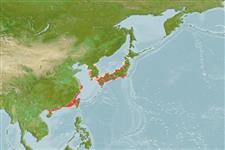Bivalvia |
Galeommatida |
Lasaeidae
Environment: milieu / climate zone / গভীরতার পরিসীমা / distribution range
বাস্তুসংস্থান
; গভীরতার পরিসীমা ? - 18 m (সূত্র 75840). Subtropical
Western Pacific.
Length at first maturity / আকৃতি / Weight / Age
পরিপক্কতা : Lm ? range ? - ? cm
Intertidal to subtidal, on rocks and coral heads (Ref. 75840). Nestling among masses of Barbatia candida and Saccostrea cuccullata at the sublittoral fringe (Ref. 77675).
Life cycle and mating behavior
পরিপক্কতা | প্রজনন | ডিম ছাড়া | Eggs | ডিম্বধারন ক্ষমতা | Larvae
Members of the class Bivalvia are mostly gonochoric, some are protandric hermaphrodites. Life cycle: Embryos develop into free-swimming trocophore larvae, succeeded by the bivalve veliger, resembling a miniature clam.
Pilsbry, H.A. 1904 New Japanese marine Mollusca: Pelecypoda. Proceedings of the Academy of Natural Sciences of Philadephia 56(2):550-561. (সূত্র 77683)
IUCN Red List Status
(সূত্র 130435: Version 2025-1)
CITES status (সূত্র 108899)
Not Evaluated
Not Evaluated
Threat to humans
Human uses
| FishSource |
হাতিয়ার
আরো তথ্য
ট্রফিক বাস্তুতন্ত্র Food items (preys)
পথ্য উপাদান
খাদ্য গ্রহণ
শিকারী প্রাণী সমূহ
Population dynamicsবৃদ্ধি
Max. ages / sizes
Length-weight rel.
Length-length rel.
Length-frequencies
Mass conversion
প্রাচুর্য
Life cycleপ্রজনন পরিপক্কতা ডিম্বধারন ক্ষমতা ডিম ছাড়া EggsEgg developmentLarvae Physiologyঅম্লজান ব্যবহার
Human RelatedStamps, coins, misc.
ইন্টারনেট সুত্র
Estimates based on models
Preferred temperature
(Ref.
115969): 12.4 - 22, mean 18.7 (based on 157 cells).
